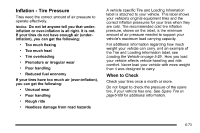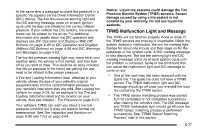2010 Chevrolet Silverado 1500 Regular Cab Owner's Manual - Page 519
2010 Chevrolet Silverado 1500 Regular Cab Manual
Page 519 highlights
When you end this high‐speed driving, return the tires to the cold inflation pressure shown on the Tire and Loading Information label. See Loading the Vehicle on page 5‑29 and Inflation - Tire Pressure on page 6‑73. See Inflation - Tire Pressure on page 6‑73, for information on proper tire inflation. Tire Pressure Monitor System The Tire Pressure Monitor System (TPMS) uses radio and sensor technology to check tire pressure levels. The TPMS sensors monitor the air pressure in your vehicle's tires and transmit tire pressure readings to a receiver located in the vehicle. Each tire, including the spare (if provided), should be checked monthly when cold and inflated to the inflation pressure recommended by the vehicle manufacturer on the vehicle placard or tire inflation pressure label. (If your vehicle has tires of a different size than the size indicated on the vehicle placard or tire inflation pressure label, you should determine the proper tire inflation pressure for those tires.) As an added safety feature, your vehicle has been equipped with a tire pressure monitoring system (TPMS) that illuminates a low tire pressure telltale when one or more of your tires is significantly under‐inflated. Accordingly, when the low tire pressure telltale illuminates, you should stop and check your tires as soon as possible, and inflate them to the proper pressure. Driving on a significantly under‐inflated tire causes the tire to overheat and can lead to tire failure. Dual Tire Operation When the vehicle is new, or whenever a wheel, wheel bolt or wheel nut is replaced, check the wheel nut torque after 100, 1,000 and 6,000 miles (160, 1 600 and 10 000 km) of driving. For proper torque and wheel nut tightening information, see Removing the Spare Tire and Tools on page 6‑92. The outer tire on a dual wheel setup generally wears faster than the inner tire. Your tires will wear more evenly and last longer if you rotate the tires periodically, see Tire Inspection and Rotation on page 6‑80. Also see Scheduled Maintenance on page 7‑3. { WARNING: If you operate your vehicle with a tire that is badly underinflated, the tire can overheat. An overheated tire can lose air suddenly or catch fire. You or others could be injured. Be sure all tires (including the spare) are properly inflated. 6-75
















